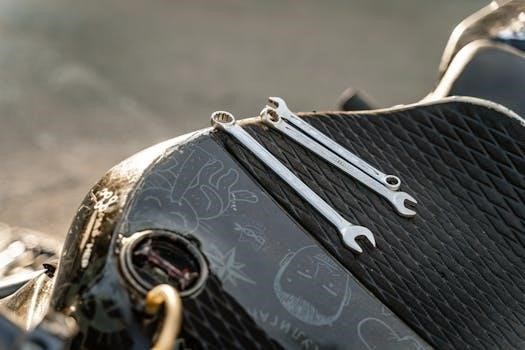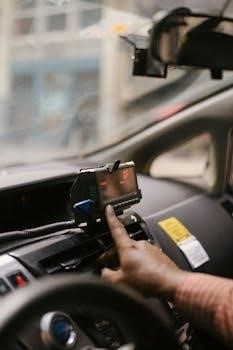
Manual Car Seat Won’t Move⁚ Initial Troubleshooting
The first step when facing a stuck manual car seat is to consult your vehicle’s owner’s manual‚ as it often contains troubleshooting options. Many times‚ the manual may contain information that can help you free your seat.
Check the Owner’s Manual
Before attempting any repairs on a stuck manual car seat‚ your vehicle’s owner’s manual is a great starting point; it may contain specific troubleshooting steps tailored to your car’s make and model. Look for sections that discuss seat adjustments or common issues. The manual might offer guidance about the seat’s mechanisms and how to release them manually or how to fix a jam. Many times the manual may contain troubleshooting options that can help you free your seat. It can explain how the seat rails and locking mechanisms function‚ providing a better understanding of what could be causing the issue. This initial check can prevent unnecessary attempts and help you solve the problem easily and safely. If you still need further assistance‚ then you can look at the next steps.

Common Causes of a Stuck Manual Car Seat
Several issues can cause a manual car seat to get stuck‚ including obstructions in the rails‚ small objects causing interference‚ or bent locking pins preventing the seat from moving.
Obstructions in the Seat Rail
One of the most common reasons for a manual car seat getting stuck is the presence of obstructions within the seat’s rail system. These rails‚ often U-shaped bars running under the seat‚ can easily trap small items. Coins‚ especially dimes‚ are frequent culprits‚ slipping into the rail and blocking the smooth movement of the seat. Other small objects‚ such as pens‚ toys‚ or even food debris‚ can also find their way into these areas. A thorough visual inspection of the seat rails is essential to identify these obstructions. Look carefully along the entire length of the rails‚ both on the driver and passenger side‚ to ensure that there are no foreign objects interfering with the mechanism. Removing these items can often resolve the problem quickly and easily‚ restoring the full functionality of your car seat.
Coin or Small Object Interference
Often‚ the culprit behind a jammed manual car seat is something as simple as a coin or small object that has found its way into the seat mechanism. These items‚ usually coins‚ can easily slip into the seat adjustment rail‚ causing the seat to lock up. Look closely under the seat for any foreign objects that might be obstructing the movement of the seat‚ especially in the U-shaped tracks. Coins can get lodged in these tracks‚ preventing the seat from sliding forward or backward. It is crucial to inspect thoroughly along the length of the seat rail‚ both on the driver and passenger side. Removal of these small objects can immediately resolve the issue‚ restoring the full range of motion to your seat.
Bent or Disengaged Locking Pins
Another common reason for a manual car seat becoming stuck is due to issues with the locking pins. These pins are responsible for engaging and securing the seat in a specific position along the track. Sometimes‚ these pins can become bent‚ preventing them from properly releasing when the adjustment lever is activated. Alternatively‚ the locking pins might not fully engage when the seat is moved‚ causing the mechanism to jam. A firm shake or jostle of the seat might help to re-engage the locking pins. The paddles that engage these pins can also become bent or hyper-extended‚ which keeps them from working. It is important to inspect these locking pins and paddles for any visible damage or misalignment.

Mechanical Issues and Solutions
If your manual car seat is stuck‚ the issue might stem from the seat’s adjustment mechanism. Pumping the lever‚ manually releasing the mechanism‚ and inspecting for broken parts are good solutions.
Pumping the Adjustment Lever
Sometimes‚ a jammed car seat mechanism can be freed by simply manipulating the adjustment lever. Start by pumping the seat lever downward three or four times in a firm manner. Following this‚ pull the lever up sharply. This action may disengage any stuck gears or locking pins within the seat’s internal mechanism. It is similar to a quick‚ repeated motion that can help to realign parts that have become misaligned. After doing this‚ attempt to move the seat again by using the lever as you normally would to see if the issue has been resolved. If the seat still doesn’t move‚ this means that the problem lies elsewhere. This method is often effective for minor jams and is a good starting point before moving to more involved solutions. Make sure that all actions are performed gently but firmly to avoid any damage.
Manually Releasing the Mechanism
If the pumping method does not work‚ the next step is to attempt to manually release the seat mechanism. To do this‚ raise the seat as high as it will go‚ and then‚ working from underneath the rear of the seat‚ you can try to manually disengage the mechanism using a screwdriver or similar tool. The intention is to manipulate the internal components to bypass the jammed locking pins or gears. This approach will likely require some careful maneuvering of the screwdriver to apply pressure to the correct points. Be cautious not to damage any parts of the seat mechanism while attempting to release it. If the mechanism releases‚ you should be able to move the seat again. However‚ if it does not‚ this means that the problem might be with broken parts.
Inspecting for Broken Plastic Gear Teeth
If the manual release method fails‚ inspect the seat mechanism for broken plastic gear teeth. A common cause of a stuck seat is damage to the plastic gears within the adjustment mechanism. These gears can break or become damaged‚ preventing the seat from moving. If the seat seems jammed or if the cranking mechanism is difficult to turn‚ it’s likely the gears are the problem. Start by removing any plastic covers under the front of the seat to access the mechanism. Look closely at the gear teeth for any cracks‚ breaks‚ or missing pieces. If you find that the gear teeth are indeed damaged‚ replacing the damaged components will be necessary to restore the functionality of the seat’s adjustment mechanism.

Advanced Troubleshooting and Repairs
If basic troubleshooting fails‚ consider replacing the seat control lever or seeking professional help. More complex mechanical or electrical issues may require expert intervention for a successful repair.
Seat Control Lever Replacement
If your car seat is still stuck after attempting basic fixes‚ the seat control lever might be the problem. A bent or hyper-extended lever can prevent the locking pins from engaging properly‚ causing the seat to jam. Inspect the lever for any visible damage or deformation. Sometimes the paddles connected to the lever become bent‚ which can stop the seat from moving. If the lever is damaged‚ replacement is necessary. Consult your vehicle’s manual or a professional mechanic for guidance on how to properly replace the seat control lever. It is important to follow the correct procedure‚ as improper installation can lead to further issues. Make sure to disconnect any wires connected to the seat before removing it from the car. This can help to avoid any electrical accidents. Once the new lever is installed‚ ensure the seat moves smoothly‚ testing its full range of motion.
Professional Assistance
If you’ve tried troubleshooting and simple fixes like pumping the lever or checking for obstructions‚ and your manual car seat remains immovable‚ it’s time to seek professional help. A qualified mechanic has the expertise and tools to diagnose and repair complex mechanical issues within the seat’s adjustment mechanism. They can identify problems such as broken internal components‚ damaged gears‚ or issues with the seat rails that may not be obvious to the untrained eye. Attempting complex repairs without proper knowledge can potentially cause more damage‚ so consulting a professional ensures the issue is resolved correctly and safely. They can also provide advice on whether it’s better to repair or replace the seat. They can accurately diagnose any issue‚ and fix it for you‚ so that you can be safe and comfortable.

Safety Considerations
When attempting any repairs on your car seat‚ even a manual one‚ always ensure the engine is off and there is no electrical power going to the seat‚ if applicable. Remember‚ safety first.
Disconnecting Power Before Repair
Before you begin any work on your car seat‚ it’s crucial to prioritize safety‚ especially if your vehicle has any electrical components related to the seat‚ such as sensors or seatbelt pretensioners. Disconnecting the power ensures you won’t accidentally trigger these systems. While the focus is on manual seat mechanisms‚ many modern vehicles incorporate safety systems that can be affected by seat movement‚ making it wise to err on the side of caution. You might need to disconnect the negative terminal of the battery to fully cut off the power supply to the vehicle’s electrical system. Consult your vehicle’s manual for specific instructions on disconnecting the battery and any related safety precautions. This step is not just about preventing electrical issues; it also reduces the risk of accidental injury during the troubleshooting and repair process. Remember‚ safety first‚ always.

